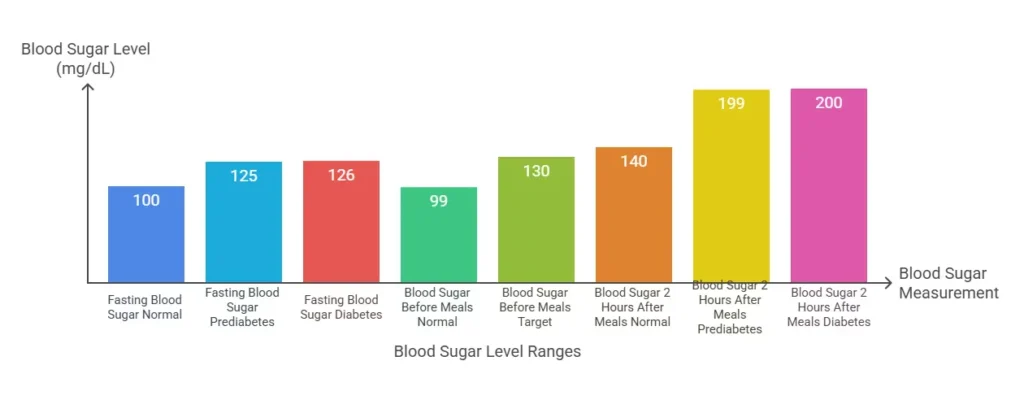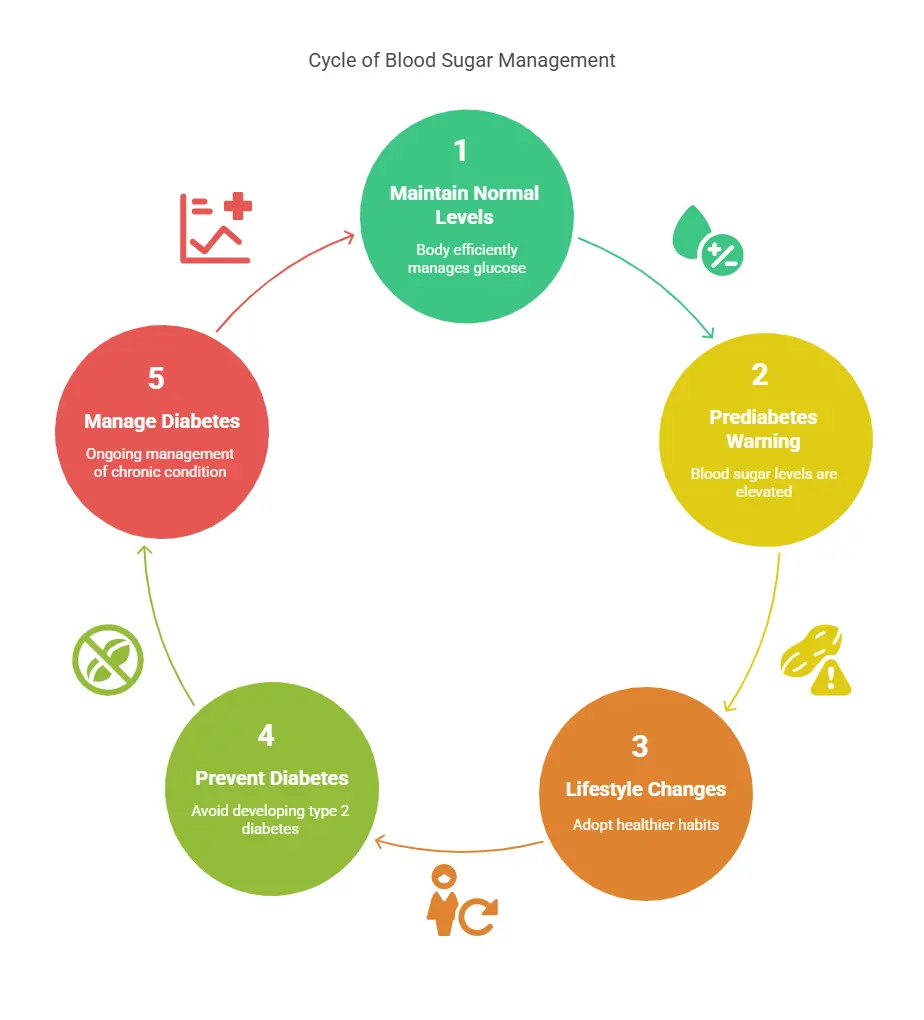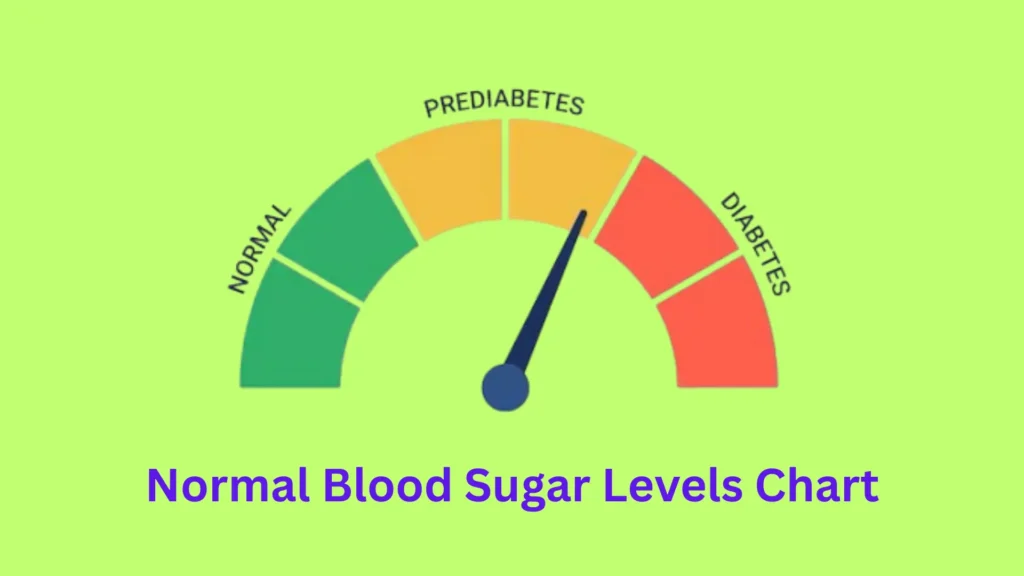Did you know nearly 1 in 3 adults in the United States has prediabetes? Most don't even know it. Knowing the normal blood sugar levels chart is key for better health. It helps prevent serious diabetes complications.
For a healthy person, blood sugar levels should be between 70 to 100 mg/dL. A reference chart helps me track my progress and make smart health choices.

Being aware of my blood sugar readings is vital. Using normal blood sugar levels chart helps me stay on track for a healthier life. It's important to understand how to read the chart to get the most out of it.
Key Takeaways
- Know Your Numbers: Normal blood sugar levels chart vary depending on when you test (fasting, after meals, or A1C). Understanding these ranges is crucial for your health.
- Normal vs. Prediabetes vs. Diabetes: There are clear lines between healthy levels, prediabetes (where levels are high but not yet diabetes), and full-blown diabetes. Catching high levels early can prevent serious problems.
- Regular Monitoring Matters: Whether you have health concerns or not, knowing how to measure and interpret your blood sugar levels empowers you to take control of your well-being.
Understanding the Normal Blood Sugar Levels Chart
Now, let's get to the numbers! When we talk about a normal blood sugar levels chart, we're looking at different ranges depending on when you test your blood sugar. These numbers are usually measured in milligrams per deciliter (mg/dL) in the United States and some other countries, or in millimoles per liter (mmol/L) in many parts of the world. I'll provide both for clarity.
It's important to know that these are general guidelines. Your doctor might give you slightly different targets based on your age, health conditions, and lifestyle.
Key Blood Sugar Measurements and Their Ranges
Here's a breakdown of the typical ranges:
- Fasting Blood Sugar: This is your blood sugar level after you haven't eaten or drunk anything (except water) for at least 8 hours. It's usually measured first thing in the morning.
- Normal: Less than 100 mg/dL (5.6 mmol/L)
- Prediabetes: 100 to 125 mg/dL (5.6 to 6.9 mmol/L)
- Diabetes: 126 mg/dL (7.0 mmol/L) or higher on two separate tests
- Blood Sugar Before Meals: This is your blood sugar right before you eat a meal.
- Normal (for most non-diabetic adults): 70 to 99 mg/dL (3.9 to 5.5 mmol/L)
- Target for people with diabetes (as advised by doctor): 80 to 130 mg/dL (4.4 to 7.2 mmol/L)
- Blood Sugar 2 Hours After Meals (Post-Prandial): This measures how your body handles carbohydrates. Your blood sugar naturally rises after eating, and then insulin helps bring it back down.
- Normal: Less than 140 mg/dL (7.8 mmol/L)
- Prediabetes: 140 to 199 mg/dL (7.8 to 11.0 mmol/L)
- Diabetes: 200 mg/dL (11.1 mmol/L) or higher
- A1C Test (Glycated Hemoglobin Test): This is a different kind of test. It doesn't give you an instant snapshot of your blood sugar, but rather an average of your blood sugar levels over the past 2 to 3 months. It's a great indicator of long-term blood sugar control.
- Normal: Below 5.7%
- Prediabetes: 5.7% to 6.4%
- Diabetes: 6.5% or higher

Normal Blood Sugar Levels Chart: At a Glance
| Measurement Type | Normal (Healthy) | Prediabetes | Diabetes |
| Fasting Blood Sugar | Less than 100 mg/dL | 100-125 mg/dL | 126 mg/dL or higher |
| (8+ hours without food) | (Less than 5.6 mmol/L) | (5.6-6.9 mmol/L) | (7.0 mmol/L or higher) |
| 2 Hours After Eating | Less than 140 mg/dL | 140-199 mg/dL | 200 mg/dL or higher |
| (Post-Prandial) | (Less than 7.8 mmol/L) | (7.8-11.0 mmol/L) | (11.1 mmol/L or higher) |
| A1C Test (Average over 2-3 months) | Below 5.7% | 5.7% – 6.4% | 6.5% or higher |
“Knowing your blood sugar numbers is the first step towards taking charge of your health. It's like having a map to guide your journey.”
The Difference Between Normal, Prediabetes, and Diabetes
Understanding the chart isn't just about memorizing numbers; it's about knowing what those numbers mean for your health. Let's dig a bit deeper into the three main categories:
Normal Blood Sugar Levels Chart
When your blood sugar levels consistently fall within the “normal” range, it means your body is doing a great job of managing glucose. Your pancreas is producing enough insulin, and your cells are responding well to it, efficiently taking up glucose for energy. This is the ideal state for optimal health and reduced risk of chronic diseases.
Prediabetes: A Wake-Up Call
Prediabetes is a condition where your blood sugar levels are higher than normal, but not yet high enough to be diagnosed as type 2 diabetes. It's a warning sign, a yellow light telling you to slow down and pay attention. Many people with prediabetes don't have any noticeable symptoms, which is why regular check-ups are so important.
The good news? Prediabetes is often reversible! If you're diagnosed with prediabetes, it's a golden opportunity to make lifestyle changes that can bring your blood sugar back to normal and prevent type 2 diabetes from developing. I've heard many stories of people who, after a prediabetes diagnosis, completely changed their habits – eating healthier, exercising more – and successfully avoided diabetes. It's truly empowering!
Diabetes: A Chronic Condition
Diabetes, specifically type 2 diabetes (the most common type), occurs when your body either doesn't produce enough insulin or doesn't use insulin effectively. This leads to persistently high blood sugar levels. Unlike prediabetes, type 2 diabetes is a chronic (long-lasting) condition that usually requires ongoing management, which might include lifestyle changes, medication, or even insulin therapy.
Without proper management, diabetes can lead to severe health complications over time, as I mentioned earlier (heart disease, kidney failure, nerve damage, blindness). That's why early diagnosis and consistent management are so crucial.

Factors That Influence Your Normal Blood Sugar Levels Chart
Your normal blood sugar levels chart aren't static; they fluctuate throughout the day and are influenced by a variety of factors. Understanding these can help you better manage your levels.
- Diet: This is probably the biggest influencer!
- Carbohydrates: Foods high in carbohydrates (sugars and starches) have the most direct and immediate impact on your blood sugar. Refined carbs (like white bread, sugary drinks) cause quicker, higher spikes than complex carbs (like whole grains, vegetables).
- Fiber: Foods rich in fiber (fruits, vegetables, whole grains) slow down sugar absorption, leading to a more gradual rise in blood sugar.
- Fats and Proteins: These have less direct impact on immediate blood sugar levels but can influence how quickly carbs are absorbed and contribute to overall calorie intake, affecting weight.
- Physical Activity: Exercise is fantastic for blood sugar! When you're active, your muscles use glucose for energy, which helps lower blood sugar levels. Regular exercise also makes your body more sensitive to insulin.
- Stress: When you're stressed, your body releases hormones like cortisol, which can cause your blood sugar to rise. Chronic stress can make blood sugar control much harder.
- Sleep: Not getting enough quality sleep can negatively affect your insulin sensitivity and make your blood sugar levels higher. Aim for 7-9 hours of good sleep each night. 😴
- Medications: Certain medications, like steroids, can raise blood sugar levels. If you're on medication, always discuss its potential side effects with your doctor.
- Illness and Infection: When you're sick, your body releases stress hormones that can increase blood sugar. Even a common cold can temporarily throw your levels off.
- Dehydration: Being dehydrated can make your normal blood sugar levels chart appear higher because the glucose in your blood becomes more concentrated. Drink plenty of water! 💧
- Hormonal Changes: Hormones play a big role. For women, menstrual cycles and menopause can cause blood sugar fluctuations. During pregnancy, gestational diabetes can develop.

How to Measure Your Blood Sugar
Knowing your numbers is powerful, but how do you actually get them? There are several ways to measure blood sugar:
- Home Blood Glucose Meters: These are small, portable devices you can use at home. You prick your finger with a tiny needle (lancet), put a drop of blood on a test strip, and insert the strip into the meter. It gives you a reading in seconds. This is great for daily monitoring and seeing how different foods or activities affect your levels.
- Continuous Glucose Monitors (CGMs): CGMs are wearable devices that measure glucose levels in the fluid just under your skin, constantly, throughout the day and night. They can send readings to your phone or a receiver, giving you a detailed picture of your blood sugar trends. This is particularly useful for people with diabetes to fine-tune their management.
- Lab Tests:
- Fasting Plasma Glucose (FPG) Test: This is the standard test for diagnosing prediabetes and diabetes. It's a blood test taken after an 8-hour fast.
- Oral Glucose Tolerance Test (OGTT): For this test, you fast, then drink a sugary solution, and your blood sugar is measured at specific intervals (usually 1 and 2 hours) to see how your body processes glucose.
- A1C Test: As mentioned, this blood test provides an average of your blood sugar over 2-3 months. It doesn't require fasting.
When and How Often Should You Test?
For people without diabetes, regular check-ups with your doctor usually include a fasting blood sugar or A1C test every few years, or more often if you have risk factors.
If you have prediabetes or diabetes, your doctor will give you specific instructions on how often to test at home. This might be:
- First thing in the morning (fasting)
- Before meals
- Two hours after meals
- Before bedtime
- Before and after exercise
Always follow your doctor's advice on testing frequency.
Real Stories: The Impact of Blood Sugar Awareness
I've seen firsthand how understanding and acting on blood sugar information can change lives.
Take Sarah, for example. She's a busy mom in her late 40s who felt tired all the time and was slowly gaining weight. During a routine check-up, her doctor told her she had prediabetes. Sarah was shocked because she didn't feel sick. Her fasting blood sugar was 115 mg/dL, and her A1C was 6.1%. Instead of panicking, Sarah saw it as a call to action.
She started walking 30 minutes every day with her dog, swapped sugary sodas for water, and focused on eating more vegetables and whole grains. She learned to read food labels and made small, sustainable changes. Six months later, her fasting blood sugar was back to 92 mg/dL, and her A1C was 5.5%. Her energy levels soared, and she even lost 15 pounds! Sarah's story is a powerful reminder that prediabetes is not a life sentence; it's an opportunity for positive change.
Then there's Mark, a retired teacher who was diagnosed with type 2 diabetes a few years ago. He initially struggled to keep his blood sugar in check. His doctor suggested he start monitoring his blood sugar at home more frequently. Mark used his meter to see how different foods affected him. He noticed that a seemingly healthy fruit smoothie sent his blood sugar soaring, while a meal of chicken and vegetables with a small portion of brown rice kept it stable. This personalized insight empowered him to make better food choices. By consistently monitoring and adjusting his diet and activity, Mark has been able to keep his A1C consistently below 7%, reducing his risk of complications.
These stories highlight that knowing your numbers and understanding the normal blood sugar levels chart isn't just theory; it's practical knowledge that can lead to a healthier, happier life.
Addressing Common Myths and Misconceptions
There's a lot of information floating around about blood sugar and diabetes, and not all of it is accurate. Let's clear up a few common myths:
- Myth: Only heavier person get diabetes.
- Fact: While being heavier person or higher weight is a major risk factor for type 2 diabetes, it's not the only one. Genetics, age, ethnicity, and other lifestyle factors also play a role. People of all shapes and sizes can develop diabetes.
- Myth: Eating too much sugar directly causes diabetes.
- Fact: While a diet high in sugar can contribute to weight gain and insulin resistance (which are risk factors for type 2 diabetes), eating sugar itself doesn't directly cause diabetes. Type 1 diabetes is an autoimmune condition, and type 2 diabetes develops from a combination of genetic and lifestyle factors. However, limiting added sugars is definitely a good strategy for overall health and blood sugar control.
- Myth: You'll know if your blood sugar is high.
- Fact: In the early stages of high blood sugar (like prediabetes), you often won't have any noticeable symptoms. That's why regular check-ups and screenings are so important. Symptoms like increased thirst, frequent urination, and unexplained weight loss usually appear when blood sugar levels are significantly high and have been for some time.
- Myth: People with diabetes can't eat any sugar or carbs.
- Fact: This is a common misconception. People with diabetes can and should eat carbohydrates as part of a balanced diet. The key is to choose healthy, complex carbohydrates in appropriate portions and to monitor how they affect blood sugar. It's about smart choices, not complete avoidance.
Here's an interactive tool to help you quickly check how a single blood sugar reading might fit into the general ranges we discussed. Remember, this is a simplified guide and should not replace professional medical advice.
🩸 Blood Sugar Level Checker 🩸
Enter your blood sugar reading and select the unit to see its general classification.
Conclusion
Understanding your normal blood sugar levels chart is one of the most proactive steps you can take for your health. It's not about fear; it's about empowerment. By knowing your numbers, recognizing what affects them, and making smart lifestyle choices, you can significantly reduce your risk of serious health problems and enjoy a life full of energy and vitality.
Remember, every small step counts. Whether it's choosing water over soda, taking a brisk walk, or getting an extra hour of sleep, these actions add up to a healthier you. Take control of your blood sugar, and you'll be taking control of your overall well-being. Your body will thank you!








